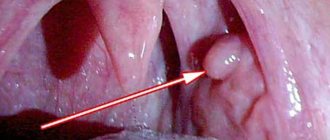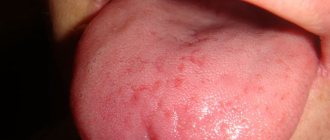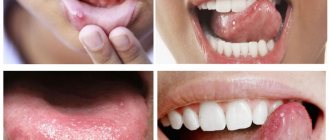Types of acquired red moles on the body
- Simple (capillary). Proliferation of newly formed capillaries, small venous and arterial vessels. Looks like a red spot.
- Cavernous. A spongy cavity with blood - a red or bluish nodule. Often forms under the skin.
- Branched (racellose). A plexus of tortuous dilated capillary trunks. They pulsate, noise and trembling are detected. It is rare and occurs on the extremities or face. If injured, life-threatening bleeding may occur.
How to identify hemangioma? Press on top of it and it should fade or disappear.
Types of oral hemangiomas
There are several types of oral hemangioma.
Capillary hemangiomas
Tumors of this type arise on small blood vessels - capillaries. They appear as small single or multiple spots that may protrude above the skin level. With strong growth, capillary hemangioma can involve other vessels and organs. A capillary type tumor usually does not penetrate deeply into the vessel cavity. If in rare cases it grows deeply, it affects muscles and bone tissue, disrupting their basic functions. Capillary hemangioma on the lip can often be injured during eating, talking, moving facial wrinkles, smoking, etc.
Pyogenic granuloma
It is a tumor that is located on the stalk. It occurs singly and does not exceed one centimeter in size. The cause of such a tumor is most often trauma, in which an infection enters the wound. The discharge of purulent-bloody fluid may be observed from the neoplasm. A similar tumor occurs in the lip area, under the tongue and on the inside of the lips and cheeks.
Are red moles dangerous?
In themselves, these formations are harmless and are not precancers.
If you have a lot of red moles on your body, the cause may be a serious liver or pancreas disease. Pay attention to this - this is a reason for examination.
Problems may arise in case of traumatization of hemangiomas. Even fairly small formations threaten heavy bleeding, which is not easy to stop.
Clinical case
Patient L, 26 years old, presented with a traumatized mass in the axillary region. According to her, she tore off a convex hemnagioma with the edge of a rigid corset of a wedding dress almost a few minutes before the start of the wedding ceremony. The hemangioma bled very heavily and a large blood stain appeared on her white dress. She had to wear the witness's jacket over her wedding dress. It was in such a strange outfit that the wedding took place.
Features of the occurrence of hemangioma on the lips
Scientists suggest that congenital hemangioma is a consequence of improper development of the circulatory system during the embryonic period. Doctors note that there is a direct relationship between the appearance of characteristic spots on the baby’s lip and infectious diseases suffered by the mother during pregnancy. The circulatory system of an embryo is formed in the first three months of its life. If the expectant mother suffers a viral or fungal disease at this time, the fetus is likely to have the described defect on the body or lip after birth.
Causes of hemangioma in adults:
- hereditary predisposition,
- vascular disorders,
- excessive passion for tanning.
Depending on what form of the disease develops, certain symptoms appear.
Etiology of neoplasms
External factors remain the main reasons for the development of lip cancer in patients of all age groups. The pathological process develops against the background of regularly repeated mechanical, chemical, temperature and meteorological influences.
The most common mechanical injuries are damage to the red border of the lips during shaving, systematic removal of keratinized epithelium (biting with teeth or tearing off with fingers). Often the cause of damage to the lips is cuts that appear due to low-quality dentures or sharp edges of damaged teeth.
Oncologists include smoking and drinking excessively hot food and drinks as dangerous thermal effects. Regular interactions with carcinogens during the patient’s professional activities are included in the group of chemical factors. Dangerous weather conditions include excessive amounts of ultraviolet radiation, high humidity and low air temperatures. In 10–15% of cases, cancer of the lower or upper lips develops against the background of human infection with the herpes simplex virus type 1.
Diagnostic methods
To detect such a pathology, an x-ray of the lower jaw and chest organs is taken. If there is a suspicion that the tumor has grown into the bone, a CT scan of the facial bones is performed.
The X-ray technique is based on the fact that X-ray radiation is attenuated differently when passing through different tissues of the human body. The result is a summation image. CT provides a layer-by-layer image of internal structures, so the extent of the tumor process can be analyzed more accurately.
If the doctor suspects that there are metastases in the bones, he gives a referral for osteoscintigraphy. For the study, a radiopharmaceutical is injected into the patient and then its distribution and accumulation in the bones is recorded using a gamma camera.
To diagnose lymph nodes, an ultrasound of the soft tissues of the neck is performed. This safe and affordable method produces transverse images using high-frequency sound waves produced by the transducer. When the sound wave returns to the sensor, it takes digital form and appears on the monitor as dots or echoes.
Images can be obtained in any plane and appear in real time during the examination. To confirm the diagnosis, a smear or scraping is taken from the tumor ulcer, which is sent for cytological examination to the laboratory. Biomaterial obtained by puncture from metastatic lymph nodes is also sent for cytology. For research, the material is prepared in a special way and stained, after which it is examined under a microscope. In this way, the pathologist can determine the type of tumor.
In preparation for surgery, in order to clarify the functional status of the body, additional examination may be prescribed, because surgical intervention is always a risk for the patient.
Statistics
In relation to all cancers, lip cancer in Russia ranks 15th in terms of prevalence among men (1.5%) and 20th among women (0.53%). According to data for 2014, 1,958 new cases of this disease were identified in Russia. In the vast majority of cases (85-90%), cancer affects the lower lip.
In 2015, 398 people (2.99%) died from cancer of the oral cavity, lip, and pharynx in St. Petersburg.
In general, statistics for St. Petersburg indicate that the incidence of lip cancer is decreasing: in 1980, 811 cases were registered, and in 2009 – 416.
Tests and diagnostics
To diagnose the disease, the patient is initially examined. In this case, both a routine examination and stomatoscopy (cheiloscopy) are used. Using this technique, you can determine the characteristics of the ulcer, the condition of the mucous membrane around the lesion and other indicators.
During diagnosis, the following examinations can be used:
- A survey of the patient, during which the doctor necessarily finds out information about the patient’s profession, contacts with harmful substances, etc.
- Inspection and palpation of the affected area, as well as the submandibular region and neck.
- Ultrasound examination of the lip, abdominal organs, lips.
- X-ray of the lower jaw.
- Orthopantomography.
- Cytological examination of smears if ulceration is present.
- Biopsy of the affected area.
- Puncture of enlarged lymph nodes in the neck.
- Laboratory tests - blood and urine tests.
- If necessary, such general clinical studies are carried out - ECG, etc.
- PET-CT is also sometimes prescribed. This study is carried out to assess how the body responds to the treatment, whether a relapse of the disease is observed, and what stage of the disease the patient has.
Therapeutic measures for a confirmed diagnosis
The treatment strategy for lip cancer is determined by the oncologist, taking into account the stage of development of the malignant neoplasm. A significant factor is the patient's chronic diseases and the presence or absence of a secondary infection.
Stage one lip cancer allows for surgery, during which doctors excise the affected areas. Sometimes oncologists refer patients for radiotherapy. The second stage of the pathological process forces doctors to pre-irradiate the tumor. After this, radical surgery is performed. Stage three cancer will require long-term radiotherapy. The affected areas are the red border of the lips and the lymph nodes affected by metastases. The remains of the tumor and lymph nodes are excised during surgery.
Stage four cancer requires more complex treatment. The patient is undergoing radiotherapy and chemotherapy. After this, surgeons perform a wide excision of the affected tissue. At the terminal stage of the pathological process, people suffering from a malignant tumor of the lips receive palliative treatment (courses of chemotherapy and radiotherapy).
Symptoms of pathology
The primary signs of lip cancer are lumps or ulcers on the surface of the anatomical area in question. Some patients complain of moderate itching, which intensifies at night or during meals. In the absence of treatment, the size of the primary lesion increases, and the soft tissues lose their original shape. Acute pain syndrome does not allow the patient to eat solid food. The upper and lower lips do not close together, and drooling appears. Cosmetic defects intensify, the tumor process affects the mucous membrane of the oral cavity, gums, cheeks and tissues of the lower jaw.
An external examination of the affected area allows the oncologist to see a dense formation with a grayish-brown surface covered with ulcers and cracks. In the later stages of lip cancer, signs of weeping appear and the tumor begins to bleed. Several seals can be combined into one large unit. Invasion of the primary lesion into bone tissue often leads to destruction of the lower jaw.
Venous lake on the lower lip
Venous lake is often found on the lower lip. It looks like a painless soft nodule of dark blue color.
Rice. 4. Venous lake on the face
Typically, such venous lakes appear in people who are well over 40. However, there are known cases of the appearance of a venous lake at an early age. Often, a venous lake is formed as a result of an injury to the lower lip.
Rice. 5. Venous lake on the upper lip
Rice. 6. Venous lake on the neck
Rice. 7. Dermatoscopy of the venous lake
Laser removal of a venous lake on the lower lip is carried out in two stages:
Stage 1 - laser treatment of the venous lake is carried out at low power for several minutes, which ensures deep penetration of the beam into the angioma tissue and promotes the closure of the lumen of blood vessels and blood clotting.
Stage 2 - the walls of the venous lake and blood clots are removed.
Removal of venous lake is carried out using two types of lasers:
- Nd:YAG laser,
- Diode laser.
Rice. 8. Venous lake under a microscope
Rice. 9A. Venous lake before laser treatment
Rice. 9B. Venous lake after laser treatment









